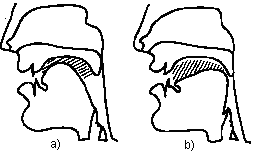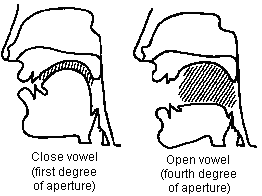The chief characteristic of the vowels is the freedom with which the airstream, once out of the glottis, passes through the speech organs. The supra-glottal resonators do not cut off or constrict the air; they cause only resonance, that is to say, the reinforcement of certain frequency ranges. A vowel's timbre (or quality) depends on the following elements:
-
the number of active resonators (among the oral, labial, and nasal cavities);
-
the shape of the oral cavity;
-
the size of the oral cavity.
There are three possible resonators involved in the articulation of a vowel: the oral cavity, the labial cavity, and the nasal cavity. If the soft palate is raised, the air does not enter the nasal cavity, and passes exclusively through the oral cavity; if the soft palate is lowered, however, air can pass through nose and mouth simultaneously. If the lips are pushed forward and rounded, a third, labial resonator is formed; if, on the other hand, the lips are spread sideways or pressed against the teeth, no labial resonator is formed.
Figure 4.1 : resonators
It is thus the number of resonators at stake in distinguishing:
-
nasal vowels (nasal resonator active) from oral vowels (no nasal resonance),
-
rounded vowels (labial resonator active) from unrounded vowels (no labial resonator/no labial resonance).
The shape of the oral cavity is determined by the general position of the tongue in the mouth. This divides the vowels into three great classes (see figure 4.2 below):
-
front vowels (tongue body in the pre-palatal region),
-
back vowels (tongue body in the post-palatal or velar region),
-
central vowels (tongue body in the medio-palatal region).

Figure 4.2 : front vowels (a) vs back vowels (b)
The size of the oral cavity is the last factor considered in the articulatory classification of a vowel. The size of the oral cavity depends directly upon the degree of aperture (of the mouth), that is, upon the distance between the palate and the tongue's highest point. Arbitrarily, four degrees of aperture are distinguished, from the most closed (first degree) to the most open (fourth degree).

Figure 4.3: close vowel (left) vs open vowel (right)
The descriptions of the vocalic articulations below are grouped according to the following principle: an initial classification is made based on degree of aperture; within each group, the vowels are then divided according to mouth shape, and then as rounded or unrounded. The study of nasal vowels is, for the meantime, outside the purview of this page.
